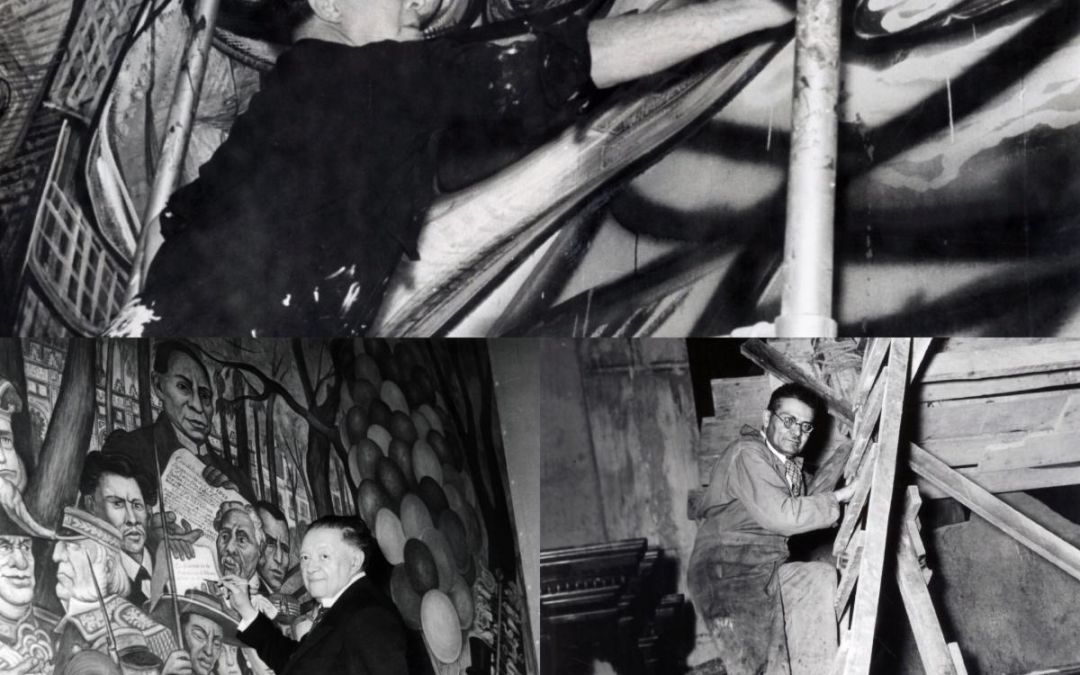
On View
M U R A L I S M
Identity & Revolution
January 30 – February 29, 2020

Throckmorton Fine Art announces a special show of photographs of Mexico’s celebrated murals and the artists who painted them in the aftermath of the Mexican Revolution. In a revolt against dictator Porfirio Díaz, the demand for agrarian reform signaled a new age in Mexico. As Civil War raged in Mexico from 1910-1920, Mexicans expressed their belief that land should be in the hands of the laborers who worked it. Mexicans also cried out for universal public education and health care, as well as broader civil liberties.
At the end of the Revolution, the government commissioned artists to create art that helped to educate the mostly illiterate masses about Mexican history. The plan was to encourage Mexicans to craft the nation’s history in a way that helped improve the welfare of the poor majority.
The images in the murals feature non-European heroes from Mexico’s illustrious past, present, and future – Aztec warriors battling the Spanish, humble peasants fighting in the Revolution, common laborers building Mexico City, and mestizos rising to dominate the future. The Mexican Revolution marked a true break from the past, launching a more egalitarian age on a grand scale. The muralists reoriented history, uncovered lost stories, and created a new narrative that can still be seen publicly in Mexico and beyond.
Three artists are especially well-known known for the way they expressed themselves through murals. Known as Los Tres Grandes, they include David Alfaro Siqueiros, Diego Rivera and José Clemente Orozco. While murals are generally defined as any artwork painted or applied directly on a wall, ceiling, or other large permanent structure, mural painting characteristically includes architectural elements of the given space incorporated into the picture.
On view are a collection of more than a dozen photographs by Tina Modotti of important murals created by Diego Rivera. He is well known for his murals of Mexican workers, miners, and laborers, created during the 1920s and 1930s. Among highlights are photographs from the murals from the Ministry of Education and National Palace including “Revolutionary Workers, Peasants and Soldiers Laughing” and the “Festival of the Flowers.” A photograph from World Wide Photo dating to 1933 depicts the mural Diego Rivera created for the Detroit Institute of Art.
The exhibition includes portraits of Los Tres Grandes, Diego Rivera by Bernard Silberstein, Edward Weston’s “Tina Reciting,” Guillermo Zamora’s 1946 portrait of David Alfaro Siqueiros, and Héctor García’s 1945 portrait of José Clemente Orozco. Other highlights of the show are iconic images influenced by the mural movement, including Manuel Álvarez Bravo’s 1928-29, “Pair of Legs,” and his 1931, “Optic Parable,” Edward Weston’s “Tina Reciting,” Florence Aguin’s 1951 portrait of Frida Kahlo, Lucienne Bloch’s 1933, “Frida in Front of Unity Panel,” Lola Álvarez Bravo’s 1942, “Judas,” Manuel Álvarez Bravo’s 1930s, “Horse in Display Window,” and Tina Modotti’s 1927, “Sickle, Bandolier and Guitar.”
The tradition that started in the 1920s continues to have its impact in Mexico and other parts of the Americas, including the United States, and many of the images shown are works that document murals that no longer survive but continue to inspire.

![]()
THROCKMORTON FINE ART
145 East 57th Street, 3rd floor, NY, NY 10022
Tel. 212.223.1059 Fax. 212. 223 1937
Info@throckmorton-nyc.com www.throckmorton-nyc.com
Are You In?
Because if you’re not in, you’re out




